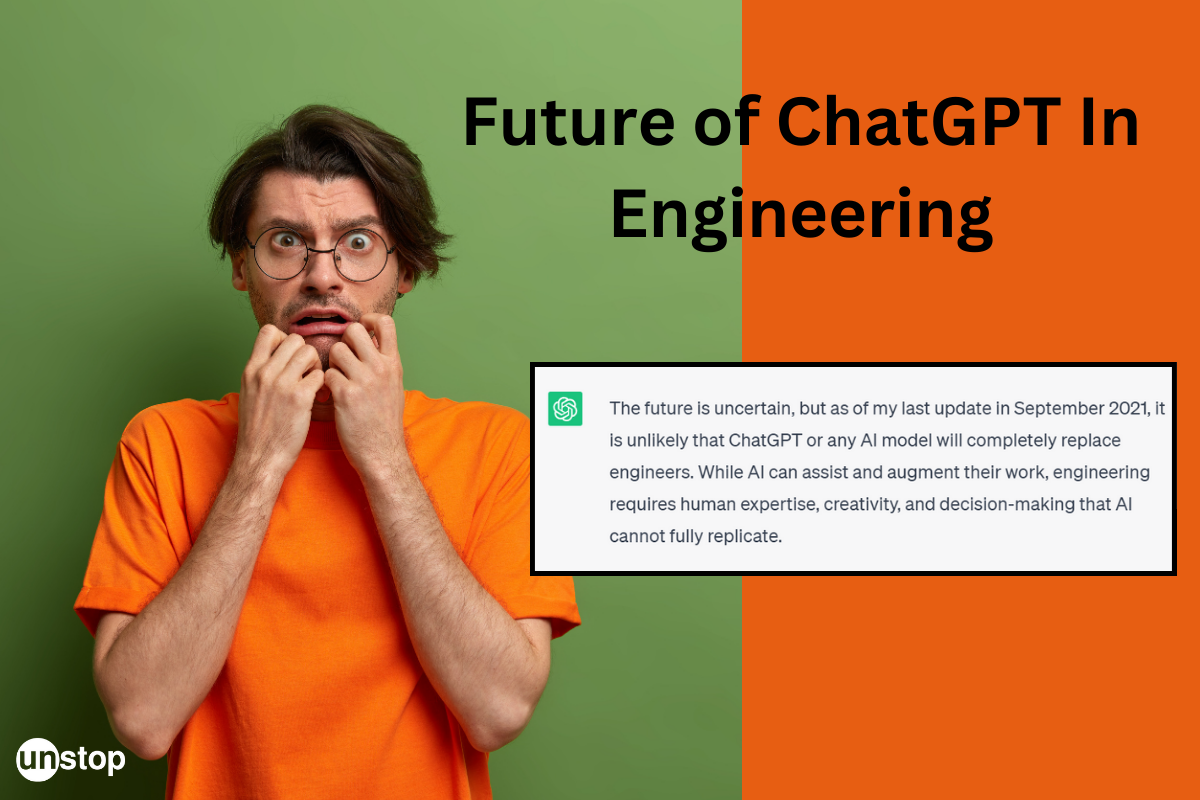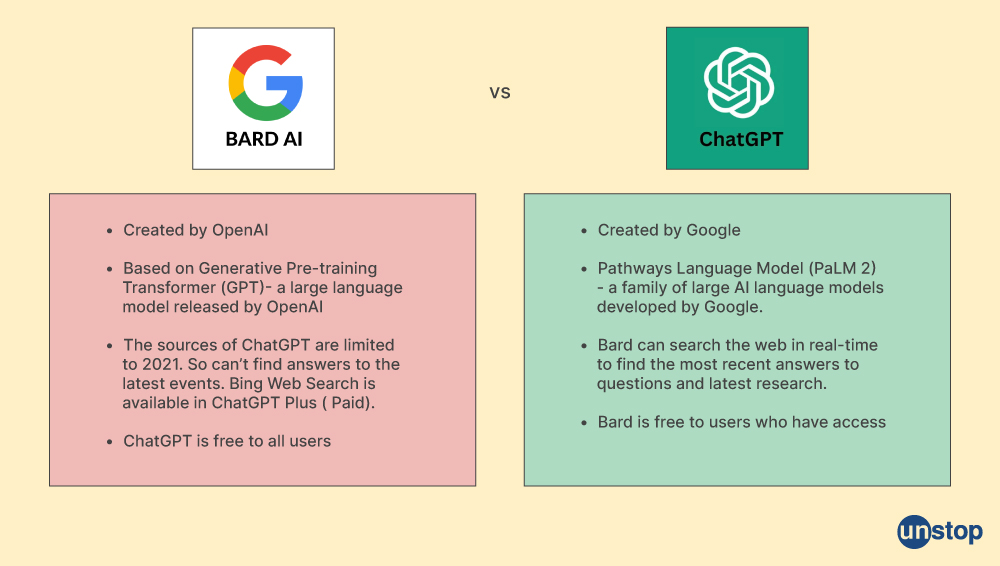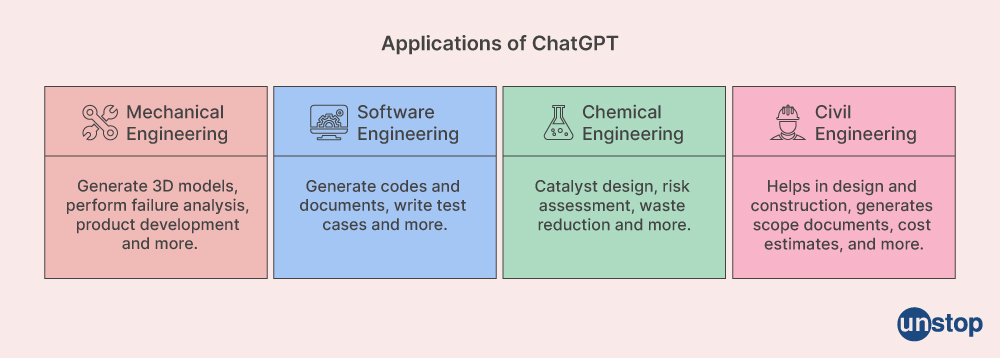- Impact of ChatGPT in Engineering
- ChatGPT in Engineering: Applications
- Future of ChatGPT: Understanding the limitations
- Peaceful Co-existence
Future Of ChatGPT In Engineering: Impact And Applications

Launched in November 2022, ChatGPT is a revolutionary tool that has generated quite a buzz all around. It is a natural language processing tool powered by AI technology that allows you to have human-like conversations and assist you with tasks, such as composing emails, essays, and code. While some people have been using this tool for frivolous purposes too, many are utilizing this technology for serious stuff, something that it is actually meant for. In this article, we will see how ChatGPT seems to have become a crucial tool for engineers and understand its impact on the engineering world.
Step up your skills with Unstop's unique courses! Explore here
Impact of ChatGPT in Engineering
Since the entry of ChatGPT, there have been speculations about the technology being capable of usurping various types of jobs in the near future. It utilizes reinforcement learning to provide real-time output that mimics human-like responses, something that couldn't be done before. This is why the rise of ChatGPT has sparked debates around the world over whether it will replace jobs, especially in the engineering domain. However, if we look at it from a practical and ergonomic perspective, Chat GPT is a helpful tool that can be used to tackle mundane tasks while the human force focuses on creativity and innovation. Hence, ChatGPT is an invaluable tool that will complement engineers in their work and lead to improved performance.
Generative AI models are based on neural networks and deep learning techniques to analyze and generate content that closely resembles human-generated responses. Thus, ChatGPT and other forms of generative AI (such as Bard) can assist engineers in performing computations, creating engineering-based text, assisting with design modeling in the early stages, generating reports, language translation, and more.

Let us have a look at the advantages of ChatGPT for engineers and engineering students across branches.
ChatGPT in Engineering: Applications

1. Mechanical engineers
From simple motors to mega-engines, mechanical engineers design machines that get the world moving. Machines such as turbines, electric generators, internal combustion engines, etc. are all creations of mechanical engineers. So when it comes to Chat GPT, mechanical engineers are expected to use the tool to help generate models that simulate physical systems, produce technical reports, perform failure analysis, conduct risk management, expedite design processes, and more. This leaves mechanical engineers with more time for tasks that are more crucial. Here are some areas where ChatGPT has proved to be useful for mechanical engineers.
- Quality control: ChatGPT can help to understand quality processes for better quality control during the development process. It can help in detecting errors or defects and accordingly adjust the production processes for delivering better quality.
- Production process optimization: ChatGPT can analyze patterns and correlate data which can lead to efficient production.
- Production planning: ChatGPT can make decisions regarding the use of suitable tools and can suggest appropriate configurations for these tools during product development process.
- Task automation: One of the most useful advantages of artificial intelligence and machine learning is that these can automate repetitive tasks. This allows mechanical engineers to focus on complex tasks, while ChatGPT deals with smaller or repetitive tasks.
2. Software engineers
Software engineers are becoming indispensable as the world becomes more and more dependent on digital and IT technology. They are responsible for making web and mobile applications, operating systems, network systems, and more. Thus, for software engineers, ChatGPT can be used to produce code structure, speed up bug detection, translate code from one programming language to another, and ensure the overall quality of coding. Following are some areas where ChatGPT can lend a helping hand to the software engineers.
- Generating codes: ChatGPT can understand and interpret what the developer intends using its natural language processing skills and generate corresponding code snippets. This may save them a lot of time, especially with regard to boilerplate codes. Not familiar with a particular programming language? ChatGPT is here to help! It can produce complex codes in a range of languages, which enables developers, especially beginners, to catch up fast. This also helps to save time and reduce errors in code generation.
- Generating documents: ChatGPT is not just a regular chat bot. Its natural language processing skills can accurately generate comprehensive documents pertaining to a function's intent, inputs, outputs, and all other relevant details. The documentation can be in the form of Markdown, HTML, or JSDoc, which makes it simpler for the developers to integrate with the same with their code editor.
- Writing test cases: ChatGPT has the ability to identify the logic and the structure behind a code. This helps the developers to write test cases by recognizing the test case's purpose and creating test inputs and expected outcomes. Not only this but ChatGPT can also be used to generate test case documentation. So developers, who don't have in-depth testing knowledge, can also update the given test cases.
Do you know there is something called as prompt engineering? Contrary to what it seems, the term is not related to core engineering. AI-based prompt engineering is the ability that allows the user to craft and refine prompts within the bounded scope of a single conversation that prevents carrying unwanted biases, and allows only the ones already present in the (pre)training dataset.
3. Chemical engineers
Chemical engineers develop and design chemical manufacturing processes by applying the principles of chemistry, biology, physics, and mathematics. They solve problems involving the production and use of chemicals, fuel, drugs, food, and other products. And for all these, ChatGPT can come in handy.
ChatGPT can be used to automate process optimization during chemical manufacturing operations, wherein any slag in the process is identified and eliminated. Also, ChatGPT can prove to be extremely helpful in new product development by considering variables that were not considered earlier. It can also provide insight into material properties and design options. Here are some functions that ChatGPT can perform.
- Predictive modeling and simulation: ChatGPT can be used to create predictive models of chemical processes that can be used to predict the behavior of processes under different conditions.
- Catalyst design and evaluation: ChatGPT can be used to design and evaluate catalysts. This helps to develop catalysts that are more effective and perform better.
- Environmental impact analysis: Waste generation is a potential issue in today's world. ChatGPT can be used to reduce waste and minimize the environmental impact of chemical processes. This makes the processes more sustainable.
- Safety and risk assessment: ChatGPT can be used to assess the safety of chemical processes which can help engineers to identify potential hazards and avoid risks.
- Assess material properties: ChatGPT can be used to predict the properties of materials that can help engineers to create materials with specific properties.
4. Civil engineering
Civil engineers design infrastructure projects such as roads, buildings, airports, bridges, tunnels, dams, and systems for water supply and sewage treatment. Civil engineers can use ChatGPT for a number of tasks in the construction industry. These are:
- Design: With the help of AI, designers and architects can create designs much faster. They can also produce alternative designs or modify an existing one using ChatGPT. So with the help of simple prompts, the ChatGPT can perform actions within minutes that can help civil engineers make informed decisions.
- Construction: ChatGPT can generate alternative drafts of designs, create bills of materials, estimate costs, etc. ChatGPT can also be helpful in suggesting alternative materials for construction in case there is a shortage of a certain material. It can also generate various options for utility, structure, power distribution, structure etc.
- Planning and risk management: ChatGPT can help in risk assessment before the commencement of a project to ensure that all possible discrete risks are properly considered.
"I knew I had just seen the most important advance in technology since the graphical user interface." - Bill Gates when he first learnt about ChatGPT
Future of ChatGPT: Understanding the limitations
ChatGPT can be an assistive tool for engineers, but it is certainly not a substitute for the knowledge and creativity of human workers. Having advantageous future prospects, ChatGPT can help engineers answer questions many questions and provide guidance on a multitude of topics. However, engineers must be able to analyze and verify data and make decisions based on multiple factors, such as technical, economic, environmental, social, and ethical considerations as well as legal issues. This requires a combination of in-depth technical knowledge, critical thinking, and creativity that cannot be replaced by ChatGPT or other AI-driven chatbots. Following are some limitations of ChatGPT.
- Common sense: Common sense in an inherent human trait and ChatGPT is deprived of this trait. While it can generate responses in human language with the help of access to a large amount of information, it does not possess common sense or personalized experiences to build the same. It lacks background knowledge, and sometimes the AI-generated content may be inaccurate.
- Emotional intelligence: ChatGPT does have many potential applications and can generate responses that appear to be human-like, but it lacks true emotional intelligence. Despite of extensive training, ChatGPT cannot respond appropriately to complex emotional situations or ethical issues.
- Inability to understand sarcasm and humor: While ChatGPT can spin out personalized responses efficiently, it can't understand sarcasm and humor, something that a human mind is trained for. While it is proficient in language processing, it can struggle to grasp the subtle nuances of human communication. For example, if a user were to use sarcasm or humor in their message, ChatGPT may fail to pick up on the intended meaning and instead provide a response that is irrelevant or inaccurate.
- Issues in writing content: If you think ChatGPT can help you write a high-quality blog post without any issues, you may be mistaken. ChatGPT faces issues in generating long-form structured content. Since it lacks emotional intelligence, it fails to deliver captivating high-quality text that follows a particular narrative or format despite being capable of writing grammatically correct sentences.
- Limitations in multi-tasking: ChatGPT is not a trained multi-tasker. It performs best when given a single task or objective to focus on. So asking ChatGPT to perform multiple tasks may muddle it up! Since it lacks the skill to segregate tasks based on priority, multi-tasking with ChatGPT might lead to inaccuracy and low efficiency.
- Potentially biased responses: ChatGPT is trained on text data that may have biases. This means the AI can give outputs that are prejudiced.
- Limited knowledge: If you pitch human knowledge against ChatGPT, there is no comparison at all. Even though ChatGPT has access to a large amount of information, it will never be able to surpass human knowledge. ChatGPT is not capable of providing answers to very specific topics or recent developments.
- High training costs and computational power: ChatGPT needs massive amounts of computing power to calculate responses based on user prompts because of the expensive servers it requires. Also, training the large language models of ChatGPT costs a lot. For Open AI, running ChatGPT costs millions of dollars a day which is why the company started ChatGPT Plus, with USD 20/month subscription plan.
Peaceful Co-existence
ChatGPT is a valuable tool that can help engineers solve complex questions and assist in their work. However, despite its range of applications, it is not a substitute for a human engineer. It has limitations and may pose ethical challenges if it is made to replace human minds. Thus, engineers will continue to play a critical role in the design and development of new products. Having said this, new engineers in the AI-driven world will need to develop new skills that enable them to leverage the power of AI tools while they upkeep their unique value as problem-solvers and innovators.
You may also like to read:
As a biotechnologist-turned-writer, I love turning complex ideas into meaningful stories that inform and inspire. Outside of writing, I enjoy cooking, reading, and travelling, each giving me fresh perspectives and inspiration for my work.
Login to continue reading
And access exclusive content, personalized recommendations, and career-boosting opportunities.
Subscribe
to our newsletter
















Comments
Add comment